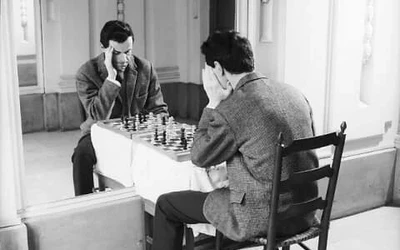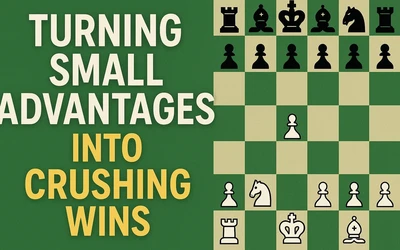
No Plan in the Middlegame? Here's What Helps (and What Hurts)
The middlegame is often where chess games are won or lost, and yet, it's a stage that many players struggle with. Whether you're feeling stuck, unsure of your next move, or simply lacking a clear plan, navigating the middlegame can be overwhelming. The key to success in this phase lies in understanding what to do — and just as importantly, what not to do. In this blog, we'll explore strategic insights and practical tips to help you approach the middlegame with more clarity and confidence. By following these guidelines, you can elevate your gameplay, and make more informed decisions that set you up for success in the endgame.Things You Really Shouldn't Do in the Middlegame:
1- Don’t Chase Threats — Build a Plan
It can feel satisfying to keep throwing out threats, hoping your opponent slips up. But good chess is about seeing the bigger picture. If you just play one threat after another without a clear plan. your opponent will likely defend them, and then you'll be left without a follow-up.
In fact, your threats can sometimes help your opponent correct their mistakes.
For example, if they have a misplaced piece and you attack it, they might simply move it to a better square. That’s a simple case, but the same idea shows up in more complex positions too.
2- Don’t Trade Pieces Just Because You Can
Trading pieces changes the nature of the game. Don’t do it without a clear purpose. Before making an exchange, ask yourself important questions: How does this trade support my overall plan? Is my piece stronger or weaker than theirs? How will this exchange affect the middlegame structure? What kind of endgame might result from it? Will it improve my pawn structure or weaken theirs? Could it expose their king or leave my position vulnerable? Mindless trades can shift the balance and hand your opponent an advantage — sometimes in subtle but decisive ways.
3- Don’t Let Emotions Make Your Plans
Don't Make Plans Based on How You Feel or What You're Afraid Of
Chess demands clarity not wishful thinking or fear-based reactions. Emotions are tough to manage (that’s a whole topic of its own), but if you let them guide your decisions, you’ll often go wrong — just like in life.
For example, if you love attacking the king, so you go all-in when you should be focusing on a passed pawn or seizing control of an important square like c6.
Similarly, if you're afraid of endgames and keep avoiding exchanging queens when it's the right strategic decision. Either way, letting emotions override logic can cost you the game.
Avoiding mistakes is crucial, but a winning game requires positive action! Let's leave behind the don'ts and step into the realm of dos for effective middlegame planning.
4- Listen to What the Board Tells You
Get over your fears and emotions, and analyze the board through its elements and imbalances (strategic or tactical, dynamic or static).
When you feel lost, focus on what’s happening right now. What does the board actually show you?
- Strategic elements: Consider weak pawns, key squares, open or semi-open files, and anything created by the current pawn structure.
- Tactical elements: Evaluate your piece activity, how well your pieces are placed, whether they’re coordinating, and the potential for fast, sharp ideas — in other words, dynamism.
- Dynamic (short-term) factors: Look at things that can change quickly, like initiative or a sudden attacking chance.
- Static (long-term) factors: Think about more permanent features, like pawn weaknesses or a lasting space advantage.
The board usually offers clues ,your job is to pay attention and listen to them.
5- Shaping the Idea: Define the Goal and Piece Roles
Once you’ve identified the key imbalance on the board (as discussed in point four), the next step is to define your goal clearly. Then, think about how your pieces can help achieve that goal. Ask yourself: What are the best squares for my pieces? How can I coordinate them to support my plan? What position do I want to ultimately reach?
While you’re still in this early phase of planning, don’t overthink how your opponent might stop you. Focus first on the potential paths your own pieces can take and the roles they can play in building toward your desired position. Avoid wasting time on moves that are obviously bad, like those leading to immediate material loss or illegal moves.
6- How My Opponent Can Fight Against My Plan?
After you have a clear plan in mind, now it's time to consider how your opponent might try to stop this plan or create their own counterplay.
Carefully evaluate their most likely responses and ask yourself: Is their plan faster than mine? Can they directly prevent my plan from unfolding? Importantly, avoid wasting time on moves that merely align with your own plan or those that don't present a real threat. Many players fall into the trap of focusing only on moves that help them achieve their own plan, neglecting to fully assess their opponent's active defenses and threats.
7- Detailed Move-by-Move Calculation
Only after thoroughly considering how your opponent might counter your plan should you begin calculating the exact sequence of moves and the correct order in which they should be played — both for executing your plan and for counteracting your opponent’s defense. Visualize the sequence: if you move here, they respond there, and so on. Understand the precise consequences of each move and the best responses to each.
Remember, we are at point seven of this process, and it is only now we’re diving into detailed, move-by-move calculations.
Once you’ve evaluated the key ways the game could unfold and feel confident in your plan while accounting for your opponent’s likely responses, only then should you make your move on the board.
Key Middlegame Tips
- Know What Plans Usually Come From Your Openings: Understanding the typical middlegame setups and goals that arise from the openings you play will give you a head start in knowing what to aim for.
- If You Want to Attack on the Side, Often It's Good to Close the Center: If your strategy involves attacking on the wings, closing the center is often a smart move to limit your opponent's counterplay, but also to prevent your forces from becoming overstretched.
When the center is open, your opponent has the opportunity to bring more pieces into the game, especially for defense. Attacking on the flanks while leaving the center open spreads your pieces too thin and can make it harder to maintain a coordinated attack. Keep the center closed to allow your attack to have more strength and focus. - Think About the Endgame While you're in the Middlegame: Many of your middlegame decisions should be influenced by the potential endgame. Consider which trades or pawn structures will benefit you in the long term. Planning for the endgame during the middlegame can guide your strategy and help you make moves that will pay off later.
- Don’t Sacrifice and Then Calculate; It Should Be the Other Way Around: Many players make the mistake of sacrificing a piece and then hoping it works out. This is a dangerous approach. Always calculate the consequences of a sacrifice before making the move. Think through the position and assess whether the sacrifice will lead to an actual advantage. Sacrifices should be calculated and planned in advance, not based on hope or guesswork.
The middlegame is often where chess games are decided. By avoiding common planning mistakes and paying attention to the board to find good strategies, you can navigate this critical phase with more confidence and increase your chances of winning.
You may also like
 nvasquez
nvasquezLearning from Jacob Aagaard
GM Aagaard was on several podcasts over the last few years, I listened to all of them. WFM Bullet_House
WFM Bullet_HouseHow to Analyze Your Own Chess Games
You can play a thousand games, but if you don't review them, you're only practicing bad habits. The … FM CheckRaiseMate
FM CheckRaiseMateThe 4 Lichess Studies I Make For Every Student
A setup to streamline your chess study routine WFM Bullet_House
WFM Bullet_HouseTurning Small Advantages into Crushing Wins
Winning without heroics You don’t need a sacrifice to win a good position. Most games are decided by… FM CheckRaiseMate
FM CheckRaiseMate15+10 Is All You Need
The simplest plan for chess improvement WFM Bullet_House
WFM Bullet_House